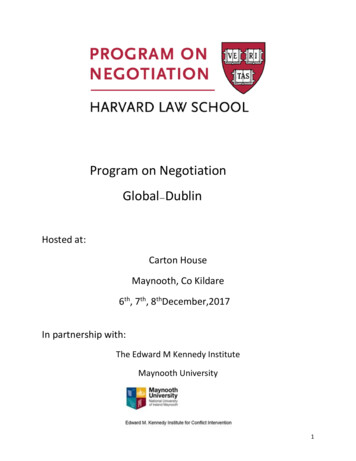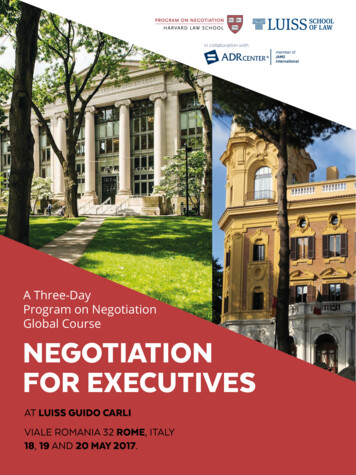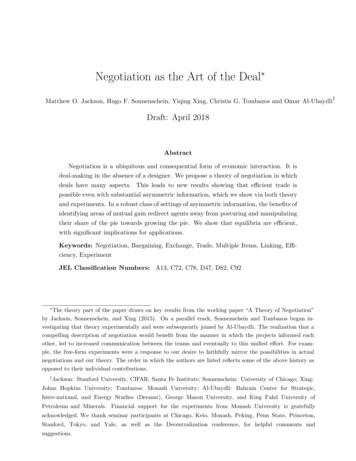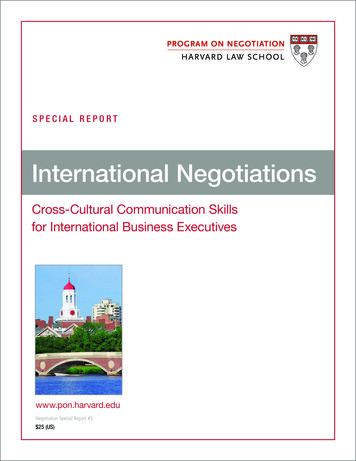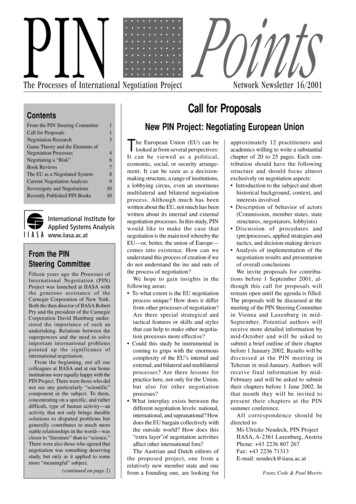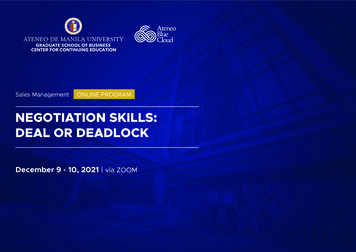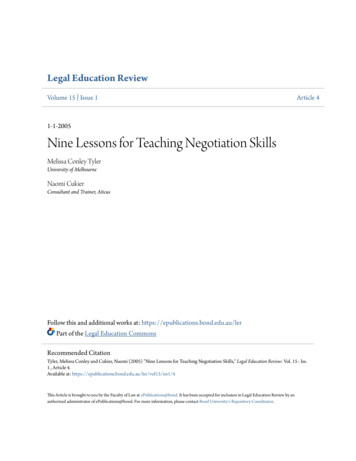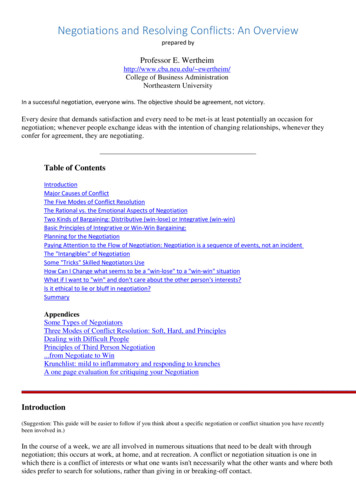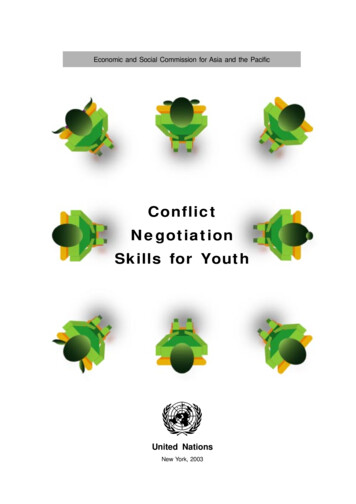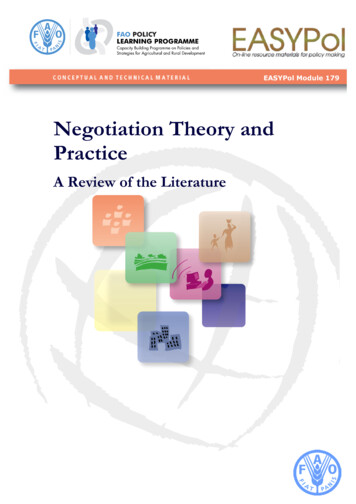
Transcription
EASYPol Module 179Negotiation Theory andPracticeA Review of the Literature
Negotiation Theory andPracticeA Review of the LiteratureTanya Alfredson, John Hopkins University, Baltimore, Maryland, USAandAzeta Cungu, Agricultural Policy Support Service, Policy Assistance andResource Mobilization Division, FAO, Rome, Italyfor theFood and Agriculture Organization of the United Nations, FAOFAO Policy Learning Programme aims at strengthening the capacity of high level policy makers in membercountries in the field of policies and strategies for agricultural and rural development by providing cutting-edgeknowledge and facilitating knowledge exchange, and by reviewing practical mechanisms to implement policychanges.About EASYPolEASYPol is a an on-line, interactive multilingual repository of downloadable resource materials for capacitydevelopment in policy making for food, agriculture and rural development. The EASYPol home page is availableat: www.fao.org/easypol.EASYPol has been developed and is maintained by the Agricultural Policy Support Service, Policy Assistance andResource Mobilization Division, FAO.The designations employed and the presentation of the material in this information product do not imply theexpression of any opinion whatsoever on the part of the Food and Agriculture Organization of the UnitedNations concerning the legal status of any country, territory, city or area or of its authorities, or concerning thedelimitation of its frontiers or boundaries. FAO January 2008: All rights reserved. Reproduction and dissemination of material contained on FAO's Website for educational or other non-commercial purposes are authorized without any prior written permission fromthe copyright holders provided the source is fully acknowledged. Reproduction of material for resale or othercommercial purposes is prohibited without the written permission of the copyright holders. Applications for suchpermission should be addressed to: copyright@fao.org.
FAO Policy Learning ProgrammeNegotiation Theory and Practice: A Review of the LiteratureTable of contents1.Introduction . 12.Negotiation and Policy-Making Processes. 23.Negotiation Theory: Foundations and Approaches . 63.1. Basic concepts of negotiation . 63.2. Negotiation approaches: An overview. 93.2.1.3.2.2.3.2.3.3.2.4.3.2.5.Structural approach . 9Strategic approach. 10Behavioral approach. 13Processual approach. 15Integrative approach . 153.3. Summary of approaches . 174. Practical Steps to Integrative Bargaining: The Seven Elements of PrincipledNegotiation. 184.1. Identifying interests.194.2. People.194.3. Alternatives .204.4. Identifying options.214.5. Criteria/Legitimacy .214.6. Commitments .234.7. Communication .245.Conclusions . 256.Readers’ notes . 266.1. Time requirements .266.2. EASYPol links .267.References and Further Readings . 26Module metadata . 31
EASYPol Module 179Conceptual and Technical Material
FAO Policy Learning Programme1Negotiation Theory and Practice: A Review of the Literature“major public policies are the outcome of a complex round of negotiationbetween interests, choices between values and competition betweenresources there are no single ‘best’ options for any player in this game, forthe ‘best’ outcome depends on what others do and what deals are possible.”(Davis et.al., 1993)1.INTRODUCTION“Pure” conflict defined as the existence of competing interests between parties in absence ofinterests that are shared, is an anomaly in international relations where the defining featureof the relationship between states is mutual dependence. Such was the observation ofThomas Schelling, noted international economist, during the height of the Cold War. In thedecades that have since transpired, globalizing developments in technology,communications, finance and trade have given rise to a world in which citizens,organizations and governments engage in millions of trans-national interactions on a dailybasis. In the modern age, the need for developing mechanisms and skills to manage dailyexchanges has grown, as has the necessity for smoothly navigating through the impassesthat arise when the satisfaction of one nation’s interests, values or goals depend on theactions or intentions of another. At the national level, policies must address, and if possible,resolve tensions between the often divergent interests of an array of stakeholders. In theagricultural sphere these may include producers, consumers, business owners, laborers andenvironmental interest groups as well as both local and national governments. Governmentsmust grapple with competing concerns related to environmental degradation, culturalpreservation, or matters of economic interest, while also upholding national commitmentsrelated to international law and commerce.It is unsurprising then, that in the decades since World War II and increasingly following theCold War, a field devoted to negotiation theory has emerged. Thanks to contributions fromscholars and practitioners across disciplines as varied as economics, law, internationalrelations, psychology, mathematics and conflict management, a literature on negotiationnow exists to help practitioners make better sense of the dynamics of negotiation.The FAO helps developing and transitioning countries to develop and modernizeagriculture, forestry and fisheries practices and to ensure good nutrition for people of allnationalities. In support of these aims, the FAO also acts as a neutral forum where nationsmeet as equals to negotiate agreements and debate policy.This paper was prepared in the framework of a capacity building programme that FAOorganized to address major strategic issues and policy challenges for agriculture and ruraldevelopment, in developing countries. The programme aimed at enhancing the capacity ofsenior officials by providing cutting-edge knowledge, facilitating exchange, and reviewingpractical mechanisms to implement policy changes in a context where policy space isincreasingly limited by regional and international agreements and treaties. Owing to the
EASYPol Module 1792Conceptual and Technical Materialincreasingly important role that negotiation plays in policy-making processes, policy expertsare becoming more and more aware of the need for mainstreaming negotiation into thepolicy cycle. To address a demand to enhance participants’ knowledge of negotiation andrelated skills, the programme contains a component which instructs on the practice ofnegotiation through a combination of theory and practical application.This paper is intended as an easy-to-read reference material on negotiation. It presents anoverview of the defining theoretical perspectives, concepts and methods that are central tothe theory and practice of negotiation.The paper is structured in the following manner. Section two discusses the relevance ofnegotiation to policy-making processes. Section three discusses the foundations ofnegotiation theory, introduces basic definitions and concepts, and provides an overview ofsome of the main schools of thought contributing to the existing negotiation literature.Section four provides an overview of the essential elements of principled negotiations, andsection 5 concludes.Readers can follow links included in the text to other EASYPol modules or references1. Seealso the list of EASYPol links included at the end of this module2.2. NEGOTIATION AND POLICY-MAKING PROCESSESIn an increasingly globalised world, policy-making is a matter of national and regional aswell as international significance. For instance, it has been argued that policy formationrelated to international trade agreements should take into account broader issues of publicwelfare, natural resource management and local subsistence economies in order not tojeopardize the development and poverty reduction prospects of developing nations andavoid an increase in domestic conflicts (Hall, 2006; Ramirez, 1999). Negotiation is a centralcomponent of national policy-making processes from setting agendas, to determining whatissues are to be addressed by policy makers, exploring options, finding solutions andsecuring needed support from relevant parties in order to ensure that planned policies aresustainable.Negotiations are a vehicle of communication and stakeholder management. As such, theycan play a vital role in assisting policy-makers to obtain a better grasp of the complexissues, factors and human dynamics behind important policy issues. Growing linkages,interdependencies and the rapid pace of change in spheres affecting important agri-foodissues including economics, trade, governance and regional and international relations, havecreated a greater need for skillful negotiators among agriculture policy-makers and experts.12EASYPol hyperlinks are shown in blue, as follows:a) training paths are shown in underlined bold fontb) other EASYPol modules or complementary EASYPol materials are in bold underlined italics;c) links to the glossary are in bold; andd) external links are in italics.This module is part of the EASYPol Training Path: Policy Learning Programme, Module 4: Policy andStrategy Formulation, Session 5: Rice Trek – Simulation game.
FAO Policy Learning Programme3Negotiation Theory and Practice: A Review of the LiteratureAgriculture policy and related issues frequently demand intricate negotiations at the level ofboth national and international frameworks. Classic examples include the processsurrounding the creation and subsequent reforms to the European Union’s CommonAgriculture Policy (CAP) as well as efforts to reduce distortions in world markets caused byagricultural protectionism and unfair trade practices of many countries that played outduring multiple rounds of international trade negotiations under the GATT and WTO(Box 1).Box 1: The CAP: An example of supranational policy-making throughnegotiationsThe CAP was a response to the crippled agricultural sector and pervasive experience with foodscarcity throughout Western Europe following the end of World War Two. Designed to meet aseries of objectives set down by member states in the 1957 Treaty of Rome, its aims were toguarantee an available and affordable food supply in Western Europe, boost agriculturalproductivity and ensure a fair standard of living for the European agricultural community.In the Treaty of Rome Europe endorsed the idea of a common market and a common agriculturalpolicy. To realize these goals however, the six founding members were faced with thechallenge of reconciling various diverging interests and of overcoming disagreement as to howtheir collective aims should be achieved. The CAP came into force five years later followingnegotiations between the two main powers of France and Germany. In a deal signed betweenCharles de Gaulle and Konrad Adenauer in 1962 France accepted a free market and a customsunion that allowed German industry access to its internal markets while Germany fed subsidiesto French farmers through Brussels. This marked the beginning of the complex CAP that we allknow, today.The CAP, revived and invigorated European agriculture but created a swath of highlyprotectionist policies in order to do so. A battery of border as well as domestic support measureswere put in place, including production subsidies, quotas and variable levies on importedcommodities, in order to provide guaranteed prices and protection for local producers. Withtime, such policies proved increasingly inefficient, trade distortive and costly to sustain. By the1980’s, the EU was store-housing vast quantities of agricultural surpluses and sustaining massiveexport-subsidy bills in an effort to dispose of surpluses on a large scale. At its pinnacle, CAPexpenditures accounted for as much as two-thirds of EU’s budget while disproportionatelybenefiting mainly the larger and richer farmers. Under these circumstances, the CAP drew moreand more criticism from international partners for creating market distortions and posing unfaircompetition to producers in countries outside the block. In addition, national constituencies grewincreasingly unwilling to pay the high price for continuing support to farmers.A movement calling for CAP reform found support among many European consumers andenvironmental groups but drew fierce resistance from Europe’s agricultural- and food-relatedindustries. Agriculture accounts for less than five percent of the EU workforce. But owing to awell organized and politically powerful farm lobby, the sector managed to keep CAP reform outof EU’s domestic policy agenda, for many years.The first serious reform of the CAP was the MacSharry reform, in 1992. Under the newmeasures, some of the support to farmers was provided as income support in the form of directpayments, rather than as support to prices. The MacSharry reform paved the way for the EU tosupport the conclusion of the Uruguay Round of International Trade Negotiations (UR) under
4EASYPol Module 179Conceptual and Technical MaterialGATT, in 1994. The agreement signed in the UR required countries to state commitments andset milestones for the gradual phasing out of border controls and reduction in their domesticsupport measures and export subsidies. The UR agreement marked the beginning of a process ofpursuing liberalisation of international trade in agriculture commodities through multilateralnegotiations. The agreement was also a result of lengthy and complex negotiations between thevarious national stakeholders. It was the latter that shaped the mandates of country negotiators atWTO, the process and ultimately the content of the agreement.In the years to follow, European protectionism and fierce international opposition to the CAPbrought the Doha round of talks under the World Trade Organization to a deadlock. Again, anintense period of public debate, domestic and inter-member negotiations ensued. During thisperiod, France, the CAP’s primary beneficiary, led a coalition of member states who lobbied tokeep production-linked subsides in place and even won support for its position from Germany,the primary financial contributor to the costly CAP. In 2003 after a decade of debate and a yearof hard negotiations, diplomatic maneuvering, public protests and lobbying efforts, the EuropeanCouncil reached a unanimous agreement for a major reform of the CAP.The 2003 CAP reform is yet another example of supranational policy-making throughnegotiations. Skillful negotiation on behalf of a French-led coalition of member states succeededin keeping production-linked subsidies in place for most farm sectors, and maintained preexisting levels of farm spending. Yet the negotiated final reform also ensured that the vastmajority of direct payments to farmers would come in the form of “decoupled” aid, therebyremoving incentives for overproduction, and encouraging farmers to produce in response tomarket forces rather than subsidies. The reforms also addressed other negotiated interests bycurbing the practice of dumping oversupply on to the world market and redirecting supportpayments towards environmental and rural development projects.In summary, negotiation processes are critical for policy-making in democratic societies, afactor with the potential to shape policy outcomes and to influence which policies areimplemented and how. This has gained increasing recognition, in recent decades. Forinstance, in the United States, a series of legislative initiatives and executive orders,including the Negotiated Rulemaking Act of 1990, direct agencies to identify rules andprocedures for negotiated “rule-making”.However the role of negotiation within the policy cycle is often only implicitly recognized.Realistically, one could conceptualize a model that recognizes the importance of negotiationtheory and skills across the core phases - agenda setting, policy analysis, formulation,implementation, and evaluation - of the policy cycle. Clearly, however, negotiation weighsmore prominently in consultations when policy agendas, options and instruments are beingdiscussed and formulated.Negotiations begin to take shape in the agenda setting phase in as far as the choice of itemsplaced on the table can set the tone and framework for the outcomes that are reached.Setting the agenda can help to either inform or restrict policy-makers thinking about a givenarea in accordance with the issues recognized as pertinent for discussion and parties selectedfor providing input and so on. Stakeholders often view agenda-setting as vital to the essenceof the policy-making process. Stakes can even be so high as to induce parties break-offdiscussions over disagreements related to agenda setting alone. At this stage, skillednegotiators can make a difference in shaping the process and overcoming anycommunication hurdles that might stand in the way of an agreement.
FAO Policy Learning Programme5Negotiation Theory and Practice: A Review of the LiteratureIn the analysis phase, policy makers must navigate through a complex array of issue areaswhere actors often comprise an increasingly diverse mix of influential parties. In light ofthese features, the formulation phase can sometimes approximate what Charles Lindblomhas called “the science of muddling through” (Lindblom, 1958). This is a process explainedby interactions that take place between decision makers, affected bureaucracies, politicalparties, interest groups and “deeper forces” - such as the business ethos, the dynamics ofinequality, or limitations in analytical capabilities. These deeper forces structure and distortthe policy process away from rational decision-making (Parsons, 1995). It is at the nexus ofthese two diverging frameworks, i.e., rational decision-making or contest of interests, thatskillful negotiation can be vital. Negotiation strategies such as perspective taking,brainstorming or focusing on interests, as opposed to positions, can be effective in helpingpolicy makers find more efficient and integrative policy solutions.During policy formulation, integrative negotiations3 can serve a function similar to that of“stakeholder analysis”, by helping to: discover existing patterns of interaction through empirical observation;improve interventions by providing analytical underpinnings to what are otherwiseintuitive actions;provide a tool to predict and resolve conflict (Hall, 2006).During policy formation, effective negotiators will identify and draw together partiesessential to an issue area, create a forum for sharing information, uncovering interests, anddefining policy options. Once policy options have been identified negotiation again plays animportant role as stakeholders and policy makers go about the business of selecting betweenavailable options and debating the merits of competing solutions. At this stage, negotiationtheory teaches that searching for a formula to address the concerns central to the problemcan help policy makers to organize their policy options into a coherent selection base fromwhich to negotiate. A winning formula is one that directs policy makers and stakeholders toconsider the key components of the problem at hand and focuses attention on principles,standards or frameworks upon which the majority of central players are most likely to agree.Because implementation authority is frequently dispersed in modern systems of governance(think of the role of member states with respect to a regional decision-making authority suchas the EU, or the reliance of a central governing authority on municipal arms of governmentfor implementation of domestic policies), policy makers who invoke lessons fromintegrative negotiation processes are more apt to produce a product that is legitimatelyperceived, and therefore implemented by the necessary parties.Some recent evidence indicates that elements of negotiation may even be helpful forinforming the evaluation stage of the policy cycle. For example, Campbell and Mark (2006)found that factors known to facilitate integrative negotiation, including awareness ofaccountability to constituencies and the structure imposed on the process of dialogue, may3A type of negotiation that often involves a process that is designed to help integrate theneeds and goals of all the involved parties through creative and collaborative problemsolving. Integrative negotiations are described in detail in section 4 of this paper.
EASYPol Module 1796Conceptual and Technical Materialbe effective in facilitating better stakeholder dialogue around programme and policyevaluation.3. NEGOTIATION THEORY: FOUNDATIONS AND APPROACHESNegotiation theories may be prescriptive, descriptive, or normative in nature. Additionally,theorists and practitioners from various disciplines have developed and utilized a variety ofapproaches or levels of analysis to improve their understanding of particular aspects ofnegotiations. The resulting theories are diverse, and frequently highlight features that reflectsalient concerns from the perspective of the disciplines from which they came. It isunsurprising then, that formal definitions of negotiation reflect the variety characteristic ofthe functional, conceptual, and disciplinary origins of the theories developed to explain it.Noted statesman and negotiator Henry Kissinger defined negotiation as, “a process ofcombining conflicting positions into a common position, under a decision rule ofunanimity” (Kissinger, 1969). Elsewhere, theorists have portrayed negotiations as events ofdiplomatic artistry, mechanical reflections of relative power, weighted interactions betweenpersonality types or rational decision-making processes. While formal definitions ofnegotiation vary, theorists do accept certain basic tenets. Foremost among them is theassumption that parties who negotiate agree in at least one fundamental respect; they share abelief that their respective purposes will be better served by entering into negotiation withthe other party. Implicitly then, negotiating parties have come to the conclusion, at least fora moment, that they may be able to satisfy their individual goals or concerns morefavourably by coming to an agreed upon solution with the other side, than by attempting tomeet their goals or concerns unilaterally. It is this mutual perception that leads to the onsetof negotiations and betrays the dependence that exists (to whatever degree) betweennegotiating parties. This common interest in a shared agreement is the starting point for the“common interest and mutual dependence that can exist between participants in a conflictwith which, Schelling writes, “negotiation is concerned” (Schelling, 1960)4.3.1.Basic concepts of negotiationStrategies and TacticsBefore turning to our discussion of the various approaches to negotiation reflected in theexisting literature, it is helpful to say a word here about strategies and tactics and how theyfit into the various schools. A strategy is “a careful plan or method, especially for achievingan end.” Whereas the use of Tactics refers to “the skill of using available means” to reachthat end5. Structural, strategic and process oriented approaches to negotiation tend to share a4This pertains to negotiations generally. However, it should be noted that in some instancesan insincere participant may enter into a negotiation not to reach an agreement but in orderto satisfy some other motive such as buying time (stalling) or perhaps to gain some politicaladvantage by virtue of being seen to enter into the process of negotiating (regardless of theparticipant’s actual commitment to seeing the negotiations succeed). Even in such cases,however, deals may sometimes be made as a consequence of the dynamics that negotiationsintroduce.5The Merriam-Webster Dictionary, 1994. Merriam-Webster, Incorporated.
7FAO Policy Learning ProgrammeNegotiation Theory and Practice: A Review of the Literaturedistributive understanding of negotiations6. These approaches involve the presuppositionthat negotiations are zero-sum transactions. In other words, negotiators look at negotiationsas contests over a limited or fixed amount of some mutually desired benefit such that oneperson’s gain is another person’s loss. The totality of available benefits is often representedmetaphorically as a ‘pie’. Because negotiators battle over a fixed amount of some good orbenefit, negotiators hope to ‘win’ a portion or ‘slice’ of the pie at the expense of acorresponding loss (of pie) by the other (see Figure 1a). This approach is in contrast toapproaches that seek to use negotiations as a way to enlarge the pie, or in other words, tomultiply gains in order to make both parties better off (Figure 1b).As a result, these approaches tend to invoke strategies that are distributive or predatorial innature. Distributive Strategies, also known as “zero-sum”, competitive, or “win-lose”strategies are based on this competitive view of negotiations. They are designed to securethe biggest slice possible of the proverbial pie for one side (also called “claiming value”),while leaving the other side with the smallest helping possible.Figure 1a: Fixed PieFigure 1b: Expanding the pieThe tactics used in distributive bargaining are therefore intended to help those who use themto claim value for themselves while defending against the efforts of an opponent to do thesame. Because competitive strategies produce win-lose outcomes, many (particularly thosewho ascribe to the integrative school) view such strategies as destructive. Examples oftactics used in distributive bargaining are provided in Box 2 below.Box 2. Tactics characteristic of distributive bargaining:Coercion:opponent.using force, or the threat of force to wrestle concessions from anOpening strong: starting out with a position that is higher than what yourealistically estimate you can achieve.Salami tactics: prolonging a negotiation to a painstakingly slow pace, onlygiving a very small concession to the other side when it can no longer be avoidedin order to placate the other side for a little while longer.(Saner, 2000)6These approaches will be discussed in greater detail later on in this paper.
EASYPol Module 1798Conceptual and Technical MaterialReservation point, bottom lines and ZOPAsWhat makes a negotiated solution possible? To answer this question, we turn briefly toseveral key concepts used in both distributive and integrative approaches to negotiations. Inany negotiation, each side has a reservation point, sometimes referred to as a ‘bottom line’.It is a point beyond which a person will not go and instead breaks off negotiations (Raiffa,1982). It is also a point that is not generally known by opposing parties and a value, whichRaiffa and others argue, should be kept secret.The reservation points of negotiating parties help to frame the likelihood and possible scopeof an agreement. To understand how, consider the following:Box 3: A sweet deal: when reservation points overlapImagine a local sugar processor and its main sugar beat supplier are negotiatinga new 3-year contract. Though the processor may hope to pay less, he knowsthat the purchase would still be worth his while at a price of up to 5Є/ton. In thisexample, 5Є/ton is the processor’s reservation point. Now imagine that thesupplier knows that (despite hoping to win a higher price through negotiations)she would be willing to sell her stock of raw sugar to the processor for aminimum of 4 Є/ton. This amount is the reservation price of the seller becausefor less than this amount the seller will not make a deal.In the case above, because there is an overlap between the maximum purchase price that thebuyer is willing to pay and the minimum sell price that the seller is willing to accept, thepair is said to possess a Zone of Agreement (Raiffa, 1982) or Zone of Possible Agreement(ZOPA) (Fisher, Ury and Patton, 1991). The ZOPA constitutes the overlap range betweenreservation points (in our example, anything between the 4 to 5 Є per ton of sugar beat). Ifthe negotiators are successful, they will come to an agreement somewhere within this range,and thus both come out better than they would have had they gone elsewhere. If, on theother hand, the maximum buy and minimum sell price do not overlap, then no ZOPA exists.An agreement in such cases is highly unlikely
related skills, the programme contains a component which instructs on the practice of negotiation through a combination of theory and practical application. This paper is intended as an easy-to-read reference material on negotiation. It presents an overview of the defining theoretical p
